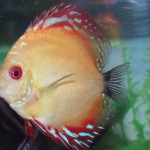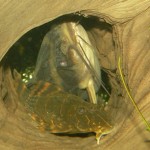Betta fish are a species of hardy, elegant and easy to care for freshwater fish. They have a labyrinth organ that acts as a set of lungs allowing the fish to breathe air at the surface, as well as a set of gills for filtering air through water. The aggressive males can only be kept alone; gill displays shown by them are beautiful but they are also a warning of their hostility to other males. Most betta lovers keep the male betta, whose long flowing fins and bright colors are much prettier than the short finned, mutely colored female. Females flare their fins as well, but they lack the flowing elegance of the male. Because of the solitary nature of the male betta, a great deal of creativity can go into decorating his tank. Some people will place a clear plastic divider in the middle of a tank and put a betta on each side of it. The resulting displays between the two males is quite beautiful behind the safety of the divider.
Bettas in the wild are not as beautiful as those loved by the betta collector. They resemble the females moreso than the well known males who are bred for their beautiful fins and markings. Betta fish are found in the rice paddies of Thailand, Cambodia and Malaysia and do not require much room; they do not roam as other fish do. Because of this, they do can do quite well in smaller bowls in a warm room of the house.
One popular betta fish display involves an aquatic plant placed on top of the water in a display called a betta vase. This isn’t without its problems because the plant could die and poison the water. Because of this, be sure the plant you are using is truly aquatic; some pet stores will try to sell terrestrial plants for the vases. When the leaves of these plants remain submerged in water, they will die and become toxic. The betta will not eat the roots of the plant as some believe, so he still must be fed, and the roots will not clean the water so the bowl still must be cleaned. Popular plants for a betta vase are the chinese evergreen, peace lilly, ludwigia, annubias nani and various types of philodendron. Great care must be excercised that the plant does not become large enough to keep the betta from being able to grab a bit of air at the surface or keep him from getting to his food; the upturned mouth of a betta makes him a surface feeder. It has been suggested that putting some straws through the plant can help the betta receive a good supply of air. Male bettas form bubble nests at the surface of the water, and will attach these nests to the floating plants. A betta vase is a beautiful display, and can be maintained with a sharp eye on the health and size of the plant, removing any dead or dying leaves promptly.
Live rooted plants are another option, but they do require a substrate at the bottom of the tank. Live plants provide oxygenation and filtration for the tank. Bettas do not require heat while some tropical aquatic plants do, so be sure to check the compatibility of your plants with your tank set up. Eelgrass is a good selection for the betta tank, as are cripts, water sprites, hygro and java ferns. Vallis, hornwort, foxtail and the amazon sword are also popular for betta tanks. These plants generally do not need excessive lighting, do well at room temperature and do not require circulated water to thrive.
While bettas can be kept at room temperature, their ideal water temperature is 75 to 85 degrees farenheit. It is at these temperatures that the true beauty of the betta can really shine. Adding a heater and mild lighting can expand your choices of plant life for the betta. Be very careful choosing a heater if you are housing a betta in a small tank, as too large a heater can overheat the water very quickly. Creeping jennies, java moss red leaf ludwigia, riccia fluitans, and banana plants are choices popular for betta tanks. Shy by nature, the betta seeks vegetation that it can hide in, around and under, so consider broad leafed plants in his tank. Multiple plants in the tank can be beneficial and creative, but always keep in mind the betta will need room to swim and get to the surface for air.
Artificial plants are a popular choice for the betta fish tank. Obviously these need no heat or light, but maintenance is required to keep algae off of them. Simply rinsing them off when you change the water is sufficient. Artificial plants are usually plastic or silk and come in an endless assortment of colors and styles. There are websites that give instructions on making artificial plants to save money and personalize the tank.Finding a plant that shows off a betta’s color is a great way to add impact to his tank, and when added to a colored background and substrate, the effect can be stunning. While artificial plants cannot die and cause toxicity, they don’t provide oxygen as a living plant does. Choosing a small, low powered aerator stone is a good way to ensure the betta is getting enough oxygen in his water. An artificial plant should still be chosen with the reticent nature of the betta in mind, and broad leafed plants are preferable.
You can house your betta fish with other tropical fish such a gouramis and mollies. He will do well with peaceful community fish, but keep an eye out for any bullying. Some fish species cannot resist nibbling on the betta’s long fins, so plants are very important if he is in a community tank.
Plants in the tank or bowl provide many benefits to the long term health of your betta. With so many plant options, betta tanks can be created to suit any liking.
Source: freshwater tropical fish
















